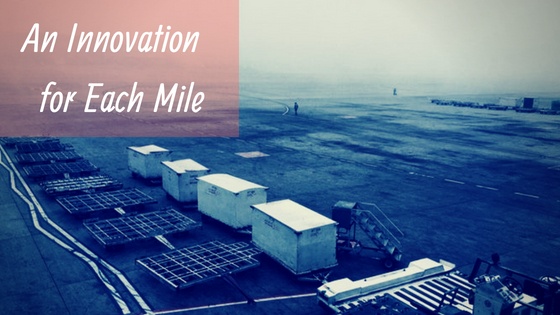How Supply Chain technologies will change business in 2020
A supply chain is a network between a business and its vendors that manufactures and distributes to the ultimate customer a particular product. This...


The constantly changing and evolving landscape of e-commerce is presenting online retailers with fresh and innovative methods of doing business online.
According to a recent report by Forbes, B2B e-commerce is expected to become a $6.7 trillion market by 2020. Not surprisingly, every business would like to see themselves as leaders in their market and online retailers have a large part to play in the development of the entire industry.
As an increasing number of entrepreneurs find themselves on online retail platforms, the platforms have designed and developed innovative tools to make business simpler for e-commerce store owners.
Customer-centric, end-to-end delivery and customer-centric services will primarily rise to power. Expect the industry to move beyond from the offer of ‘fast and free' delivery to customizable and transparent delivery options that prioritize the convenience of the customer.
The recent growth of trends like crowdsourcing and ‘same-day delivery' have given last mile delivery a new direction. When the last mile delivery is ready for disruption, supply chain organizations will need to start revamping and polishing their fulfillment processes to identify practical methods to deliver their products and services to customers.
Delivery to individuals is far more expensive and relatively inefficient when compared to delivery to businesses. Delivery service providers are tasked to reach individual packages to low populated regions, and in many instances, the receiver of the package is not present at the destination at the time. That said, customers continue to demand and expect cheaper and faster deliveries.
When it comes to food delivery, millennials are the priority audience. They spend the most significant percentage of their budget on ready-to-eat food as compared to other generations. Leading a fast-paced lifestyle, millennials are more likely to order food delivery and visit quick-service restaurants.
However, given the higher spending power, millennials also have a higher set of requirements –
Retails need to accurately identify aspects of the delivery and logistics process that can be automated. Ex – A retailer that has a wide range of products faces a complicated process when it comes to delivery. Some questions they face are (i) how to match the appropriate delivery type and delivery carrier to a particular item? (ii) from a technological viewpoint, how to automate the checkout process?
The trick here is to make use of automation and use a tool that is comes pre configured with services and carrier options along with inbuilt machine learning. The tool may rely on robust algorithms or a rule-based engine to assist it in considering many factors simultaneously, including the type of product, the order destination, the basket mix, etc. The rule-based tool will be able to display the most appropriate delivery option for each customer.
Taking a mobile-centric approach when building online stores has been in the spotlight for some time now. To a large extent, customers use their mobile devices for shopping, and it delivers a more convenient experience when executed correctly.
Google has recognized this and now rewards mobile-friendly sites by giving them a higher position on their search results. However, where some e-commerce websites have fantastic and responsive mobile-friendly sites, others are still firmly sticking with desktop versions of their sites.
Google recently changed the rules of the game again when it announced an update to its algorithm. One of the biggest takeaways from this update was to include a ‘mobile-first’ factor as one of the determinants of a site’s search result ranking.
This change has forced online retailers to develop a mobile-friendly website to stay on top of Google's search result rankings.
The amount of venture capital that is flowing into the urban logistics and last mile delivery sectors is probably the best way to showcase the growth in the gig economy as well as crowdsourcing applications.
Two thousand fifteen saw venture capital investments in logistics and supply chain start-ups quadruple from a year earlier.
Companies like UberRush (packages), Deliver, Postmates, and Amazon Flex now provide deliveries with the help of independent deliverers. Companies publish delivery jobs in their respective applications to inform drivers about available jobs. Ad-hoc collection and delivery are not as efficient as making deliveries of a package using a stable delivery route optimization system with an available vehicle that knows the destination. However, technology is become more and more advanced making it easier for those with a vehicle or even a bicycle, with a need for extra money, to be able to do so.
These services, however, are geographically restricted and currently not as widespread as traditional delivery services. They usually exist only in the larger cities. Venture capitalists are showing an increasing interest in companies that are based on information and technology instead of on assets like vehicles etc. They are more focused on companies that make use of information and analysis to identify a way to do a job for less.
Where traditional carriers have improved package traceability like tracking information and proof of delivery, local and regional last mile delivery organizations do not have access to the level of technology to provide this information.
As can be imagined, communicating with these organizations tend to become a little chaotic. Traceability and similar tracking data are critical when it comes to last-mile deliveries. This is especially critical when dealing with delayed or misplaced packages.
The rise and popularity of smartphones and GPS tracking has allowed customers to view the location of the driver or the package. This proves crucial in fast deliveries along with traceability and signature capture at the package's point of delivery. Consumers will come to increased demand this functionality and force the industry to move in this direction.
We concede these delivery options are, at best, options for the future and are still being developed and tested, however, they are sure to become a trend when they arrive sooner or later.
Once packages start being delivered by drones or stand-alone vehicles, the delivery game will change radically. Deliveries today are limited by the availability, shift, and costs of labor. Delivery by robots can be undertaken 24 hours a day. However, delivery by drones, may face certain restrictions in urban areas due to operational and regulatory constraints.
The city of San Francisco, California is already testing delivery by robots that travel the city using sidewalks. The disadvantage is that the robot currently requires human accompaniment and supervision in case it faces a problem. The management consulting firm, McKinsey predicts a future where drones and autonomous vehicles will deliver almost 80% of all packages. This will relegate traditional delivery methods to just 20% of the market share.
With the extensive penetration of smart devices as well as an abundance of delivery businesses, customers are turning increasingly demanding. Almost every business has many competitors that are ready to deliver competing products and services faster, cheaper, and offering a better experience for the customer.
Moving to the future, the focus will be on being pragmatic and being flexible enough to adapt to changes in the market. The primary consideration is that online customers demand speed and convenience. Businesses need to match the changes in their customer's tastes and trends.

A supply chain is a network between a business and its vendors that manufactures and distributes to the ultimate customer a particular product. This...

Retail in India has been undergoing significant changes since the last decade and the change has made the spread of elections easier and broadening...